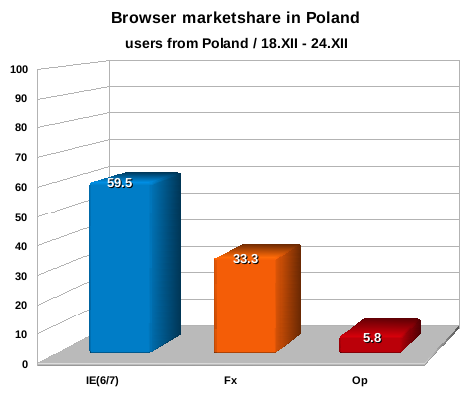The first part of this summary focuses on Poland. (part 2 – Czech Republic, part 3 – Hungary, part 4 – Lithuania, part 5 – Ukraine)
Population: 38.5 mln
Internet users: 11.4 mln (29.9%)
In case of Poland we can present two datasets (as this is the data we have from Ranking.pl) – users of the Polish Internet who come from Poland and users who come from outside of Poland.
The emigrants group is important because it brings us the numbers that should be near to Western Europe/US numbers while still in Gemius methodology.
Poland has very stable, big and well organized community lead by two projects. MozillaPL is a community project focused on self support, community activities, extension localization, and is an amazing source of energy. Aviary.pl is much smaller, task oriented group, that is considering itself as fully professional localization team, with a clear entry barrier, rules, internal structure and growing set of projects under its guide. It started as a part of MozillaPL with a goal to provide high quality localization of Firefox and Thunderbird, but now, it localizes big variety of products both commercially and non-commercially.
First, let’s take a look at the current market share of the most important browsers.
Yes, in contrast to the situation in western Europe, America and Asia, Opera does exists on our market and has its share, while Safari (0.1%) and the whole Mac platform are hardly visible.
Looking at the graph on the right, you can see the latest cumulative set with Microsoft Internet Explorer keeping the crown with 59.5% of the market share, Firefox being second with 33.3% and Opera being third with 5.8%.
In terms of engines, Gecko has 34% and MSIE has just dropped below 60% (59.9%) point.
Yes. The results are different to the ones from XiTi Monitor. According to what we know, XiTi measures websites in English, French and Spanish, so they’re most representative in western Europe. For other countries they measure users from those regions who connect to the tracked websites, which distorts the results.
Now, let’s take a look at users from outside of Poland (29% in this group is from England, 16% Germany, 14% USA, 27% other European countries, 14% rest of the world):

